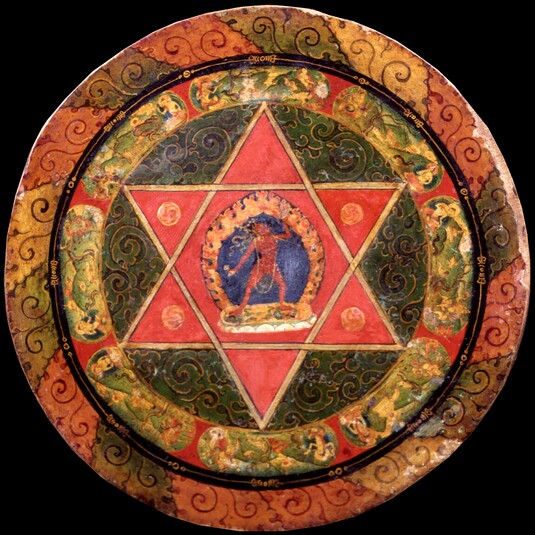
Item: Mandala of Vajrayogini (Buddhist Deity) - (Naropa Tradition)
| Origin Location | Tibet |
|---|---|
| Date Range | 1800 - 1899 |
| Lineages | Sakya |
| Size | 17.78x17.78cm (7x7in) |
| Material | Ground Mineral Pigment on Wood |
| Collection | Rubin Museum of Art |
| Catalogue # | acc.# P2001.1.1 |
Classification: Deity
Appearance: Semi-Peaceful
Gender: Female
Vajrayogini Mandala (Tibetan: dor je nal jor ma kyil khor, na ro kha chod ma). The dakini Naro Khechari from the tradition of the Indian mahasiddha Naropa.
Sanskrit: Vajrayogini Tibetan: Dor je nal jor ma
Tibetan: Dor je nal jor ma
In the center of two crossed red triangles stands Vajrayogini, red in colour, with one face and two hands. In the left hand she holds upraised to the sky a skullcup and in the right a curved knife pointed downwards. Against the left shoulder rests a katvanga staff decorated with silk streamers. Adorned with a tiara of skulls, bone ornaments and a necklace of fifty skulls, she stands with the two feet placed on the two gods Kalaratri and Bhairava, above a sun disc and lotus, completely surrounded by the orange flames of wisdom.
The two crossed triangles are each bordered by a yellow edge and the two protruding wings at each side contain small white circles. This geometric structure is placed in the middle of a green circle of swirling vine like patterns. In an outer circle are the eight great charnel grounds. Surrounding that is the small blue circle with alternating gold vajras and gold lines (Skt.: vajravali). The outermost circle is composed of the five coloured flames (Skt.: jvalavali) of the fires of pristine awareness.
Vajrayogini belongs to the 'wisdom class' of Anuttarayoga tantra and arises specifically from the Chakrasamvara cycle of Tantras. In Tibet, the practice of Naro Khechari is included amongst the 13 Golden Dharmas of Glorious Sakya. In more recent times the practice has gained popularity within the Gelugpa School.
Distant Lineage: Vajradharma, Vajrayogini, Mahasiddha Ghantapada, Tengipa, Antarapa, Tilopa, Naropa, etc.
Near Lineage: Vajradhara, Vajrayogini, Naropa, the Pamtingpa brothers, Lokkya Sherab Tseg, Mal Lotsawa Lodro Dragpa, Sachen Kunga Nyingpo (1092-1158), etc.
The painting style with dominant red and blue colours and the intricate floral background designs shows a strong Nepalese influence.
Jeff Watt 7-98
Exhibition: Mandala, The Perfect Circle (RMA)
Thematic Sets
Buddhist Deity: Vajrayogini Mandala Plate (Naropa)
Subject: Svastika - Bliss Whorl Confusion
Subject: Tetrahedron (dharmakara/dharmadayo) Main Page
Collection of Rubin Museum of Art: Mandala
Mandala: Mandala Main Page
Tradition: Sakya Deity Paintings
Collection of Rubin Museum of Art: Painting Gallery 9
Buddhist Deity: Vajrayogini Main Page
Mandalas: Sakya Tradition
Mandalas: Female Deities
Collection of Rubin Museum (Interesting Mandalas)
Buddhist Deity: Vajrayogini, Khechara Religious Context
Buddhist Deity: Vajrayogini, Khechara (Naropa Tradition)
Buddhist Deity: Vajrayogini Mandalas
Buddhist Deity: Vajrayogini, Khechari Manadala
Mandala: Ritual Mandala Plate (Wood)
Mandala: Vajrayogini Mandala Plate
